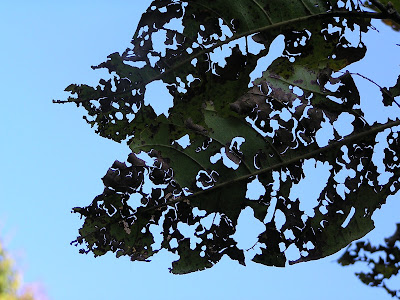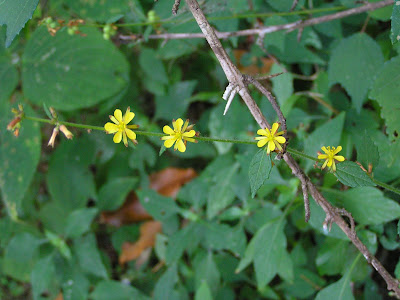Kodachaadri is a peak 1343m above sea level in the western ghats, quite close to the Arabian sea. Dec 29th saw me wind up a project, heave a huge sign of relief, and catch 22 (or 24 ?) other blokes for the KMA led trek.



We stopped at a resort like place for early morning activities. Quite a few birds around, but I just couldn't get close to any of them ;-) These leaves caught my attention. And, that insect (who-what-why). Also seen was a big bird - a kite like bird - quite far off, and I didn't have my binoc's with me.


 Hey...you see those seemingly dried brown leaves ? I had always wondered at them. These are small plants called epiphytes that grown on the big tree. They put up big leaves (those big brown stuff) in a tight circle around the stem. This enables it to catch rain water and form ponds. Falling leaves from above, decay, and pass nutrients. Birds come for water in these ponds and leave behind nitrogen rich droppings. Other visitors could be Mosquitoes, Dragonfly's, frogs, beetles, lizards, small snakes. Its party time out there! Also called Bird fern nest, and commonest of these epiphytes are bromeliads.
Hey...you see those seemingly dried brown leaves ? I had always wondered at them. These are small plants called epiphytes that grown on the big tree. They put up big leaves (those big brown stuff) in a tight circle around the stem. This enables it to catch rain water and form ponds. Falling leaves from above, decay, and pass nutrients. Birds come for water in these ponds and leave behind nitrogen rich droppings. Other visitors could be Mosquitoes, Dragonfly's, frogs, beetles, lizards, small snakes. Its party time out there! Also called Bird fern nest, and commonest of these epiphytes are bromeliads.
 A huge tree trunk lay across our path, and you see the orchids. Orchids are mostly epiphytes, and they are not parasites. Orchids have an exciting tale apart from living on other plants or rocks, their name comes from the Greek orchis, meaning "testicle". Well, Theophrastus (370-285 BC) used that term to describe a class of plants that had testicle like roots. And, the name famously stuck.
A huge tree trunk lay across our path, and you see the orchids. Orchids are mostly epiphytes, and they are not parasites. Orchids have an exciting tale apart from living on other plants or rocks, their name comes from the Greek orchis, meaning "testicle". Well, Theophrastus (370-285 BC) used that term to describe a class of plants that had testicle like roots. And, the name famously stuck.Moving on, Dragonflys here. Thanks to this online book, I got to identify them.

Flaming spike climber. All wild flowers identified here are thanks to Isaac Kehimkar's book on Common Indian WildFlowers.
 Common Jezebel on Common floss flower. One of my favourite butterfly. The plant is an aggresive invader, rampant due to felling of evergreen forests[Isaac].
Common Jezebel on Common floss flower. One of my favourite butterfly. The plant is an aggresive invader, rampant due to felling of evergreen forests[Isaac].Orchid. I thought this could be a catterpillar, and gently touched it. Notice the roots. Some dangle the roots in the air, and absorb moisture in the air. Some spread it on the branches, and absorb the water(along with any absorbed nutrient) trickling down.



By this time, it was afternoon, Jharna, Sunand & me - we had got lost - blame it on orchids & dragonflys - and were the last to reach this amazing waterfall. The path was quite adventerous - walking besides a stream, on rocks, slippery at times.
 This looks like a 'Tree frog', unfortunately I don't have a better picture.
This looks like a 'Tree frog', unfortunately I don't have a better picture. 
 Hill Blepharis. Bees polinate the flowers.
Hill Blepharis. Bees polinate the flowers.
 Common burbush. Interstingly, the lower leaves in the plant have three lobes, while those on the flowering stem have single pointed apex[Isaac].
Common burbush. Interstingly, the lower leaves in the plant have three lobes, while those on the flowering stem have single pointed apex[Isaac].
 ????????
????????



By this time, it was afternoon, Jharna, Sunand & me - we had got lost - blame it on orchids & dragonflys - and were the last to reach this amazing waterfall. The path was quite adventerous - walking besides a stream, on rocks, slippery at times.
 This looks like a 'Tree frog', unfortunately I don't have a better picture.
This looks like a 'Tree frog', unfortunately I don't have a better picture. 
 Hill Blepharis. Bees polinate the flowers.
Hill Blepharis. Bees polinate the flowers. Common burbush. Interstingly, the lower leaves in the plant have three lobes, while those on the flowering stem have single pointed apex[Isaac].
Common burbush. Interstingly, the lower leaves in the plant have three lobes, while those on the flowering stem have single pointed apex[Isaac].  ????????
???????? 
Spot the insect.
 It was a long day, my left knee showed up an earlier running injury. And, I struggled once the climb & decent began. This majorly hampered my movements, getting closer to the subjects, and having time to photograph. And, had also finished up one of the two batteries I carried. And, so got very choosy in clicking. Stayed away from people & landscape snaps.
It was a long day, my left knee showed up an earlier running injury. And, I struggled once the climb & decent began. This majorly hampered my movements, getting closer to the subjects, and having time to photograph. And, had also finished up one of the two batteries I carried. And, so got very choosy in clicking. Stayed away from people & landscape snaps.



5 comments:
Why is it that the "Common Jezebel" is soo uncommon (atleast Ive never seen it!)
Inspiring pics... :) Looking forward to the write-up.
-C
Really cool pictures man.. Looks like you think through pictures man.
eeeow!!! There you go again... there are so many wonderful places in Kodachadri... and you found only these insects???
Akash, quite good pics. Next time you are going on a trek if your ESP tells you I wont be interested or busy..so you shouldnt call me, dont listen to it, your ESP would be wrong (LOL)
Hi Akash,
The pictures are marvellous. Great going..
Deepthi.
Post a Comment